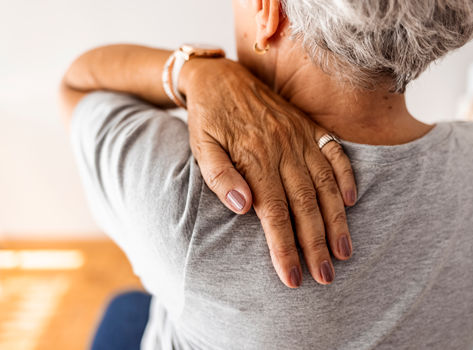
Was osteoporosis to blame for the Hunchback of Notre Dame’s curved spine? He was only a fictional character, so we’ll never know.
Osteoporosis doesn’t get a lot of attention, but it effects roughly 1 in 10 Americans over the age of 50, according to the U.S. Department of Health and Human Services. And most of the people affected are women.
So what is osteoporosis? Why are women more prone to develop this condition than men? Can osteoporosis be reversed, or are you doomed to living in fear of falling and breaking your hip?
Aristea Sideri Gugger, MD, PhD, a fellowship-trained endocrinologist with Atlantic Health System, answers these questions and explains how you can lower your risk and better manage your bone health.
What is osteoporosis?
Osteoporosis is a chronic condition caused by the loss of bone density. All healthy bones have holes for blood vessels and nerves, but with osteoporosis, those naturally occurring holes become too large, causing bones to become significantly weaker.
The gold standard test for diagnosing osteoporosis is called a DEXA scan. Using a scale that identifies healthy bone as having a T-score of higher than -1.0, a person is considered to have osteoporosis if their T-score falls to -2.5 or less.
What is osteopenia?
Osteopenia is also a chronic condition of weakening bone mass, but to a lesser degree than osteoporosis. Osteopenia can lead to osteoporosis, but it can be stopped with treatment and care.
Using the DEXA scan rating scale, people with osteopenia have a T-score between -1.0 and -2.5.
Who can develop osteoporosis?
Both men and women can develop osteoporosis, but it’s much more common in women — in large part because of the role estrogen plays in bone health.
Dr. Sideri warns that while menopause may reveal osteopenia or osteoporosis, there may be other reasons you develop it. Some common risk factors for osteoporosis include the following:
- Genetics.
- Age.
- Menopause (women).
- Hypogonadism (men).
- Steroid use.
- Smoking.
- Excessive alcohol use.
- Malabsorption issues (often caused by other conditions like Celiac disease).
- Certain medications, including those to treat breast and prostate cancer.
- Primary hyperparathyroidism (too much calcium in blood) and untreated hyperthyroidism (overactive thyroid).
- Eating disorders.
- Other health conditions such as early menopause, thyroid disease, some autoimmune diseases and other rare conditions.
Signs and symptoms of bone loss
Osteoporosis begins as a quiet, painless condition. There are no signs until there’s severe bone loss. When that happens, you’re more prone to falling and breaking bones, which can lead to chronic back pain.
In rare cases, untreated osteoporosis also can lead to height loss due to breaks along your spine. If you lose an inch and a half or more from your height, you should be evaluated and treated.
“Osteoporosis is a rather insidious condition,” says Dr. Sideri. “You usually don’t know you have it until you break a bone or get screened.”
Screening for osteoporosis
Speaking of screening, Dr. Sideri recommends the following people be screened, based on national guidelines:
- Women over age 65 (men over age 70, although the guidelines are loose).
- Anyone with a family history of osteoporosis.
- Anyone who’s lost an inch and a half or more in height.
- Anyone who’s had a low-impact fracture.
- Anyone with long-term steroid use or cancer medications, such as chemotherapy drugs that block estrogen and stop testosterone.
“If you have any of the risk factors, screen sooner,” suggests Dr. Sideri. “The earlier you catch it, the better chance you have of slowing it down.”
How to manage osteoporosis and osteopenia
Unfortunately, osteoporosis and osteopenia are not reversible, but they are treatable.
Dr. Sideri says medication can help slow further bone loss and even replace bone in some cases. However, much of the treatment comes down to a combination of lifestyle changes you can make to reduce your risk of falling and breaking a bone. She recommends the following:
- Eat a nutrient-rich diet.
- Supplement key minerals and vitamins such as calcium (helps form new bone) and vitamin D (helps the body process calcium).
- Exercise with weights or resistance bands, or use your own body weight.
- Stop smoking.
- Eliminate or reduce alcohol consumption.
Improving your overall health and wellness through good nutrition and exercise is always a good idea, and Dr. Sideri stresses the importance of regularly incorporating weight-bearing exercises for bone health — meaning exercises where you work against gravity. “This is the one time we do not suggest swimming as a good exercise choice,” she points out.
When to see a doctor
Dr. Sideri recommends making an appointment with your primary care provider or an endocrinologist for an evaluation if you have a known low-impact fracture, a predisposition for osteoporosis because of family history, or any of the previously mentioned risk factors.
“Osteoporosis doesn’t get the attention it deserves, but it can put you at greater risk of falling and greatly impact your quality of life,” explains Dr. Sideri. “Even if you feel fine, be open-minded if your doctor suggests screening or treatment. It can make a big difference in how you get to live out the second half of life.”
Be Proactive About Your Health
To stay safe and healthy, it's good to have a primary care provider who knows and understands your health history and wellness goals.